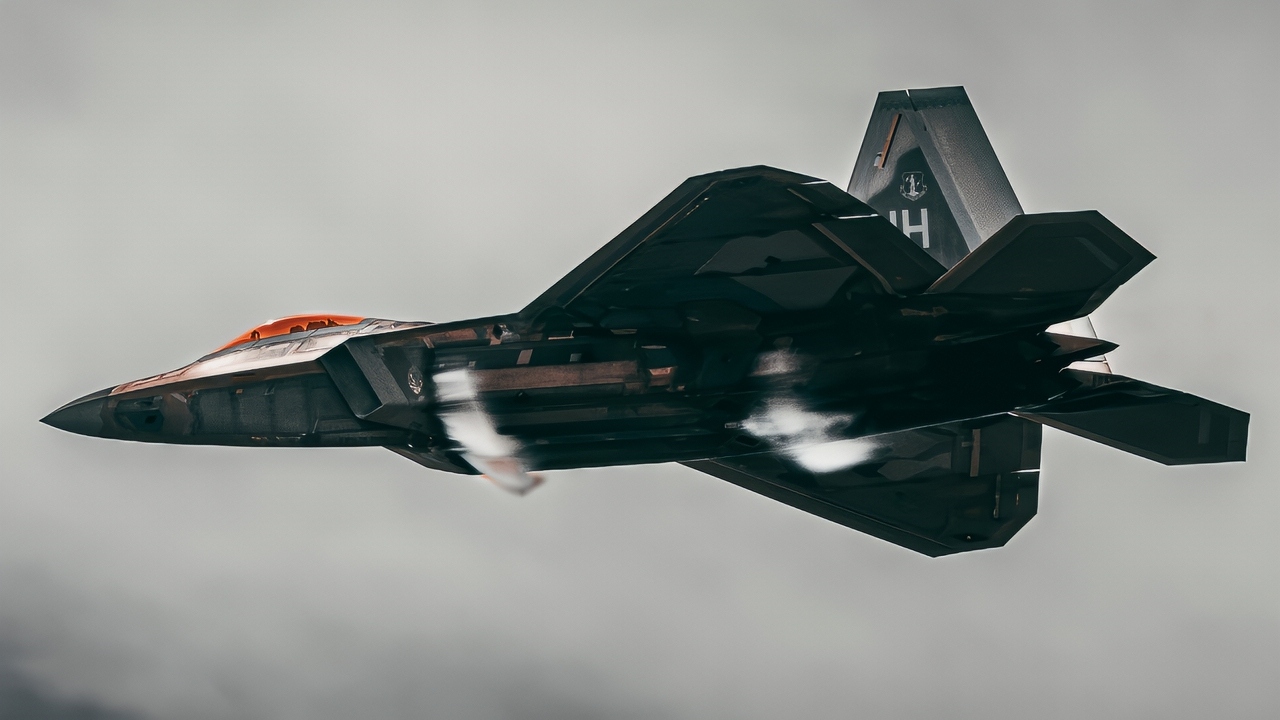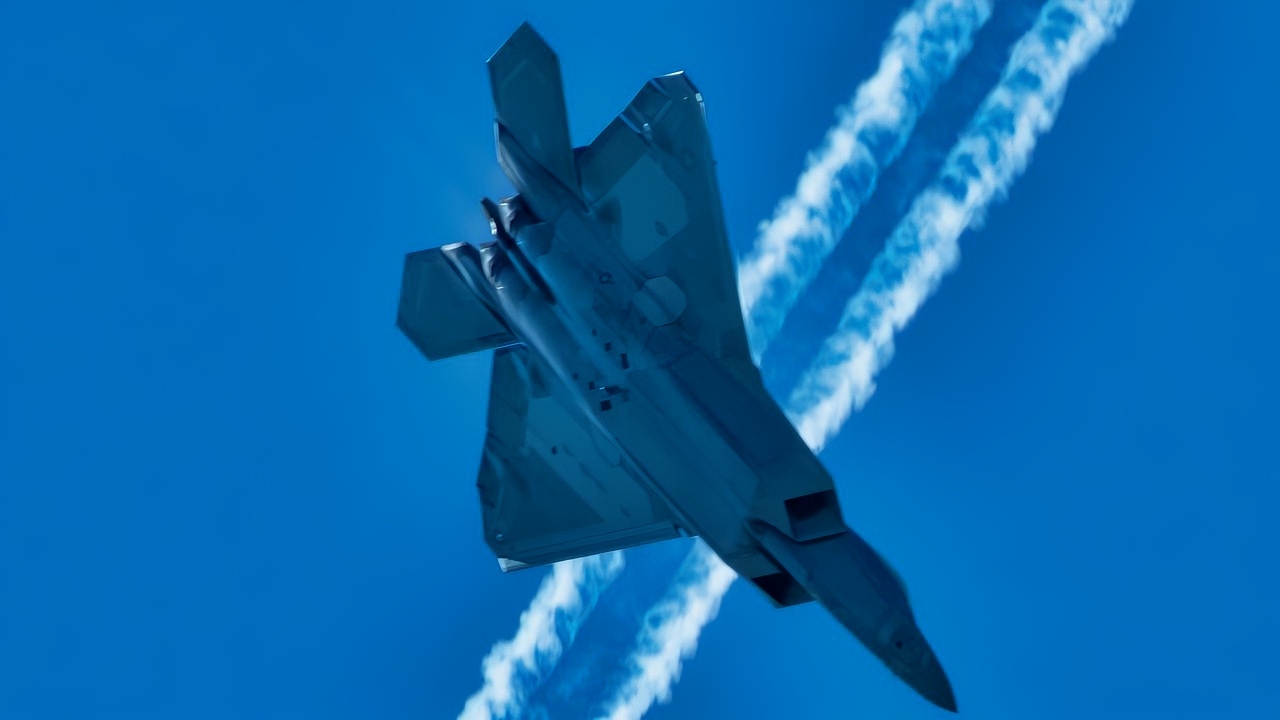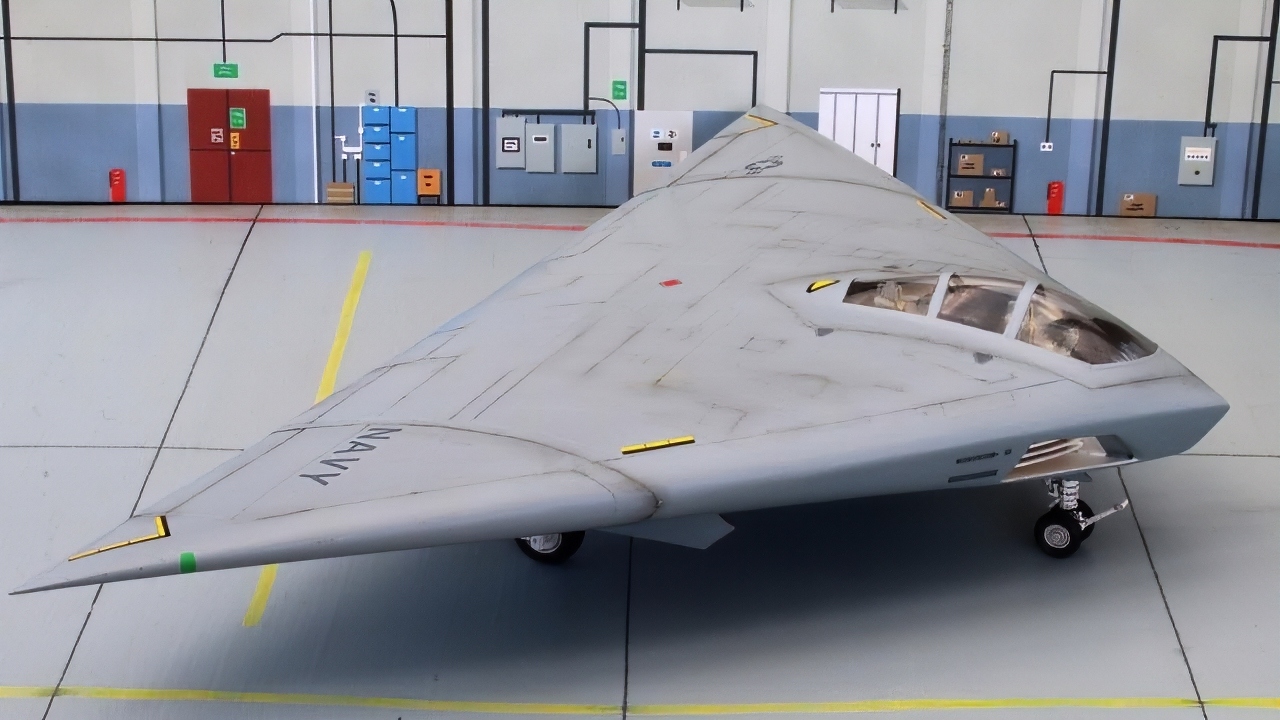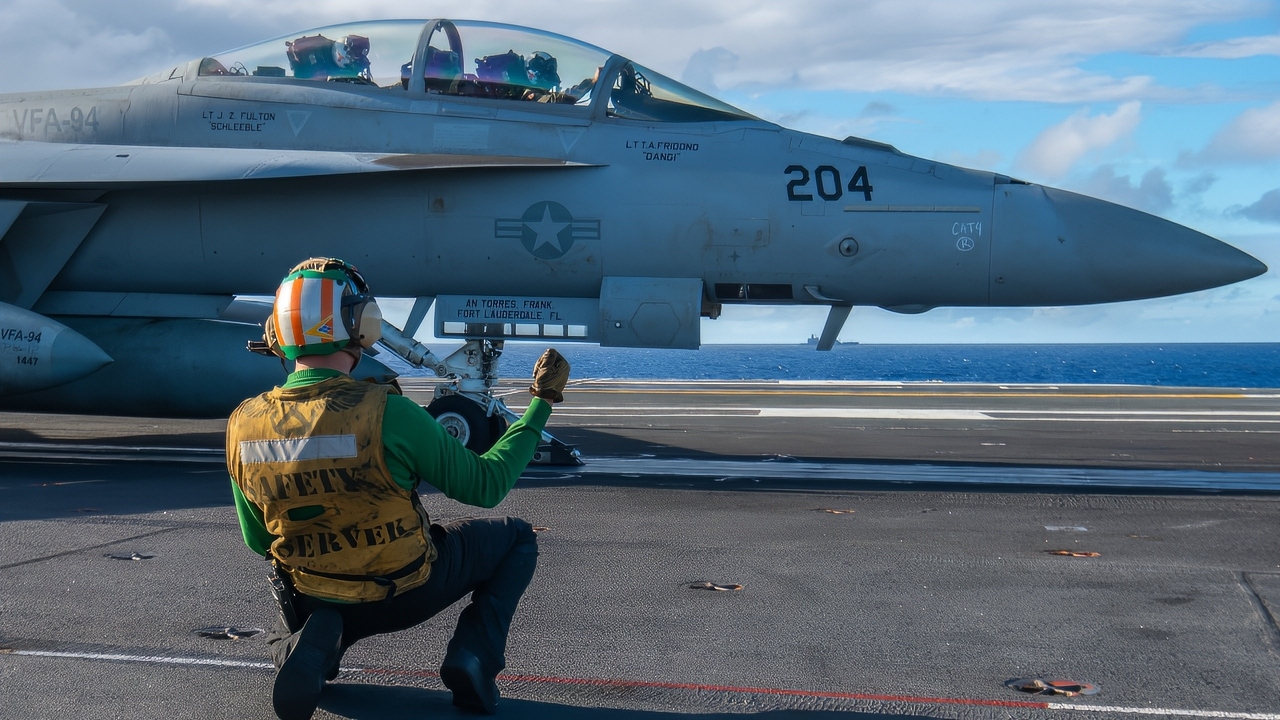Key Points and Summary – The F-22N “Sea Raptor” was the U.S. Navy’s carrier-suitable derivative of the Air Force’s F-22.
-It aimed to replace the F-14 with a stealthy, long-reach air-dominance fighter that could also strike, extend the carrier air wing’s radar horizon, and kill bombers before they launched cruise missiles.
-Engineering realities—lower approach speeds, stronger structures, corrosion protection, and deck-handling limits—drove weight and cost up as post-Cold War budgets collapsed.
-The Navy pivoted to the F/A-18E/F and later the F-35C.
In hindsight, a limited F-22N buy might have delivered a harder-hitting, farther-ranging fifth-gen punch at sea—useful against today’s Indo-Pacific threats.
The F-22N “Sea Raptor”: The Fifth-Gen Carrier Fighter That Wasn’t—And Why That Still Matters
By the late 1980s, the Navy faced a hard problem: keep carrier groups alive against long-range, bomber-launched cruise missiles and improving enemy fighters.
The notional Navy Advanced Tactical Fighter (NATF)—a navalized derivative of the Air Force’s ATF that became the F-22—promised to replace aging F-14s with a stealthy interceptor that could reach far, see first, and kill first while also carrying precision-strike weapons.

F-14 Tomcat on Flight Deck at USS Intrepid Museum. Image Credit: National Security Journal.
The concept aligned with the Navy’s fleet air defense mission: patrol far from the carrier, hunt the bombers before they could shoot, and, if needed, knock down any leakers.
A Sea Raptor would have pushed that defensive bubble outward while giving the air wing genuine fifth-generation sensor fusion.
What The Sea Raptor Would Have Built On
Start with the Raptor’s strengths: all-aspect low observability, supercruise, extreme agility, powerful AESA radar, electronic warfare, and a cockpit designed for sensor-fused decision-making. The F-22 already blends air-to-air dominance with focused strike capability, carrying precision weapons internally when required.
A naval variant would have preserved that DNA while adapting the airframe and systems for saltwater life and carrier operations—turning the Raptor from the Air Force’s air-superiority apex into the Navy’s far-forward stealth guardian for carrier groups.
How You Turn A Land Raptor Into A Sea Raptor
Carrier operations don’t forgive shortcuts. To meet launch-and-recovery realities, the Sea Raptor would have needed:
Bigger, High-Lift Wing And Control Surfaces to hit low approach speeds and safe wave-offs, with robust flaps and leading-edge devices tailored to carrier patterns.
Strengthened Structure And Gear for catapult launches and 24-ft/sec arrested-landing sink-rate design loads, plus a redesigned arresting-hook installation that worked across the stealthy aft fuselage.

A U.S. Air Force F-22 Raptor performs a high speed pass during the 2025 Marine Corps Base Hawaii (MCBH) Kaneohe Bay Air Show, at MCBH, Aug. 9, 2025. The Kaneohe Bay Air Show provided an opportunity to showcase the aircraft, equipment, and capabilities of the armed forces in the Indo-Pacific region to the local community. The air show, which contained aerial performances, static displays, demonstrations, and vendors, was designed to celebrate MCBH’s longstanding relationship with the local community. (U.S. Army photo by Pfc. Peter Bannister)
Corrosion Protection And EMI Hardening for the salty, electrically noisy shipboard environment, extending to engines, avionics, and flight-control systems.
Footprint Limits (folded-wing span, length, mass) to fit elevators and deck spots, and to allow two aircraft on the big deck elevators simultaneously—classic constraints that shaped NATF design goals.
Weapons And Sensors For The Fleet Mission: integration with the Navy’s long-range air-to-air missile concepts of the era, extended-range radar modes, and maritime strike options.
None of that is trivial; each requirement drives weight, drag, cost, and schedule.
The Air Wing It Would Have Transformed
A Sea Raptor would have reshaped the carrier air wing in three ways:
Deeper Outer Air Battle. Stealthy combat air patrols hundreds of miles out, using long-range sensors to sort bombers and shooters, then killing at range before missile release.
Sensor-Shooter Teaming. As a stealth forward scout, Sea Raptors could silently build the air picture, cueing E-2D, F/A-18E/F, F-35C, and Aegis shooters—an elegant “see first, shoot first” lattice.

U.S. Air Force Maj. Josh Gunderson, F-22 Demonstration Team pilot, soars through the sky during a demonstration practice Feb. 27, 2020, at Davis-Monthan Air Force Base, Ariz. The Heritage Flight Training Course is a training course for all single-ship aerial demonstration teams prior to the upcoming summer air show season. (U.S. Air Force Photo by Captain Kip Sumner)
Strike Under The Bubble. With internal precision weapons, a Sea Raptor detachment could open corridors or opportunistically hit time-sensitive maritime targets without broadcasting its presence.
In short, the Sea Raptor would have made the carrier’s defensive dome bigger and meaner, while adding a stealthy offensive stiletto.
Why It Died Anyway
Two forces killed the concept—physics and timing.
Physics: Navalization adds penalties. Lower approach speeds demand bigger wings and high-lift systems; carrier loads require stronger landing gear and fuselage; catapult launches drive reinforced nose structures; corrosion prevention and electromagnetic hardening add mass and maintenance.
Deck-handling rules limit size and weight; folded span, elevator dimensions and capacity cap how big and heavy a jet can be. As these constraints piled up, the Sea Raptor’s projected weight and cost climbed.
Timing: The early 1990s brought budget austerity, the A-12’s implosion, and a reshaping of naval aviation priorities. With resources tight, the Navy chose to double down on F/A-18E/F and hold out for a future carrier-suitable stealth strike fighter (what became the F-35C), rather than fund a bespoke naval Raptor on top of the Air Force’s program.

A-12 Avenger II Flying Dorito. Image Credit: Creative Commons.
The program never left the paper and wind-tunnel phase; by 1991–92, NATF and the Sea Raptor idea were shelved.
Would A Limited Buy Have Been Worth It?
Reasonable people can disagree, but there’s a strong case that a small F-22N Sea Raptor tranche—even one or two squadrons per coast—would have paid strategic dividends:
Stand-Off Threats Demand Reach. China’s concept of massed, long-range maritime strikes makes the “kill the archer before he shoots” mission essential. A Sea Raptor’s stealth, speed, and sensor fusion would have been tailor-made for deep barrier CAPs over the Philippine Sea or northern Pacific.
Network Leverage. The carrier wing isn’t a set of lone gladiators; it’s a network. A handful of Sea Raptors could have served as silent quarterbacks for E-2D, F-35C, Growlers, and Aegis, pulling detections from one vector and shooting from another, at ranges that complicate the adversary’s timeline.
Deterrence Value. The knowledge that a carrier brought fifth-gen air dominance—not just stealth strike—would have raised the threshold for maritime adventurism and reduced the value of bomber salvos.
Yes, the costs would have been real. The Navy would have inherited a second fifth-gen logistics ecosystem, separate from the Air Force and later the F-35C. Unit price, manpower, and life-cycle sustainment for a small fleet would sting.
But measured against today’s pacing threat, the strategic return might have justified a limited, high-impact Sea Raptor cadre.
What It Might Have Looked Like In Service
Imagine a WestPac deployment: two Sea Raptor divisions fly far-forward BARCAPs, relayed by E-2D and tanked by organic assets, quietly classifying air-breathing threats and cueing long-range shots while F-35Cs penetrate for strike and the Super Hornets/Growlers build the electronic picture. When bombers push, Sea Raptors ambush, thinning the salvo before it ever forms. If leakers launch, the network assigns shooters—the air wing, Aegis, and joint assets—to mop up missiles. The Sea Raptor’s value is time and geometry: it buys breathing room for the carrier group by moving the fight outward.
Why The Decision Still Stings—And What To Do Now
The Navy didn’t make a foolish choice in 1991; it made a budget-constrained one in the shadow of a collapsing Soviet threat. But the consequences landed decades later. Without a carrier-suitable fifth-gen air-dominance fighter until the F-35C matured—and with the F/A-18E/F optimized as a multirole workhorse—the air wing missed an opportunity to field a long-reach, stealth counter-air specialist.

(Dec. 31, 2022) An F/A-18E Super Hornet assigned to the “Mighty Shrikes” of Strike Fighter Squadron (VFA) 94 prepares to launch from the aircraft carrier USS Nimitz (CVN 68) to participate in a long-range maritime strike demonstration. Nimitz is in 7th Fleet conducting routine operations. 7th Fleet is the U.S. Navy’s largest forward-deployed numbered fleet, and routinely interacts and operates with 35 maritime nations in preserving a free and open Indo-Pacific region. (U.S. Navy photo by Mass Communication Specialist 2nd Class Justin McTaggart)
Two lessons for today’s programs:
Design In Carrier Reality Early. If the fleet needs a navalized variant, bring those requirements to the table before a design hardens; retconning navalization is how costs explode.
Accept Small-Fleet Economics For Unique Effects. Sometimes a dozen jets that reshape a fight are worth more than dozens that merely add sorties. The calculus should weigh operational leverage, not just flyaway price.
The Bottom Line for F-22N
A F-22N Sea Raptor wouldn’t have been cheap or easy. But as an outer-air-battle killer with stealth, reach, and fused awareness, it could have made carrier groups markedly harder to attack and more dangerous offensively.
The Navy’s choice to pass was understandable then—but looks costly now.
If there’s a do-over, it lies in ensuring the Navy’s next carrier fighter (and its teaming uncrewed aircraft) delivers the Sea Raptor’s effect: pushing the fight outward, owning the air picture, and denying the enemy the first move.
About the Author: Harry J. Kazianis
Harry J. Kazianis (@Grecianformula) is Editor-In-Chief and President of National Security Journal. He was the former Senior Director of National Security Affairs at the Center for the National Interest (CFTNI), a foreign policy think tank founded by Richard Nixon based in Washington, DC. Harry has over a decade of experience in think tanks and national security publishing. His ideas have been published in the NY Times, The Washington Post, The Wall Street Journal, CNN, and many other outlets worldwide. He has held positions at CSIS, the Heritage Foundation, the University of Nottingham, and several other institutions related to national security research and studies. He is the former Executive Editor of the National Interest and the Diplomat. He holds a Master’s degree focusing on international affairs from Harvard University.
More Military
China’s New J-35 vs. America’s F-35: Stealth Is Close. Experience Isn’t.
The B-21 Raider Stealth Bomber ‘Math Problem’ That Needs Solving
J-20 Mighty Dragon vs. the World: 5 Strengths That Make China’s Stealth Jet a Problem
U.S. Navy Nimitz-Class Aircraft Carrier: 5 Biggest Complaints
What Makes U.S. Navy Aircraft Carrier USS Harry S. Truman A Powerhouse? 1 Word.










